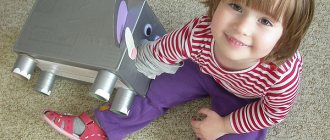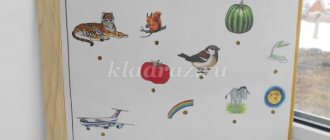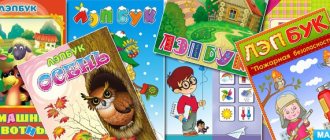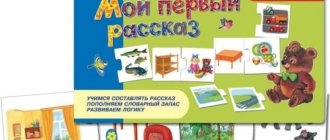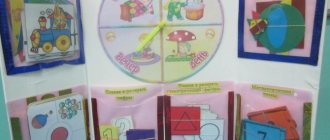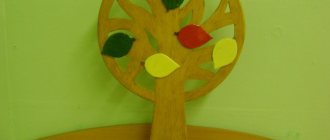Methodical manual “Do-it-yourself sensory toys”
Author:
Taut Irina Petrovna
teacher
MAU DO "Sorokinsky"
child development center - kindergarten No. 1"
The main content of the play of younger preschoolers is actions with toys and substitute objects. Children especially love to play with household objects such as sand, water, various jars, and bottles. Such activities contribute to the development of the child’s sensory system: vision, hearing, smell, taste. If a child receives a rich sensory experience in early childhood, this will help him feel much more comfortable in the future, in adulthood, and will also help him learn successfully. Now many manufacturers have begun to produce wonderful toys for children. These include educational rugs, soft books, sewn puzzles or laces. However, you can make an interesting educational toy with your own hands. Self-made sensory toys carry a charge of positive energy, warmth and tenderness of the hands, and are unique. While working with young children, I noticed that there was a need for the development of fine motor skills, so I had the idea to create a series of toys for sensory development using improvised materials. A variety of items were used: hooks, buttons, laces, Velcro and other improvised materials that can be found in any home. I was looking for various options for educational mats and tablet modules. In general, we got good benefits with a minimum of financial costs. The parents of my students provided a lot of help in making crafts. Together we sewed, glued, nailed, created, invented.
The purpose of these benefits is to develop the sensory abilities of young children, memory, thinking, imagination, develop hand motor skills, and tactile sensations.
The manuals contain tasks and exercises for sensory development, fine motor skills of the hands, speech, logical thinking, imagination, and creative abilities of the child.
All exercises are easy to perform. Their regular repetition contributes to the development of gross, fine and articulatory motor skills, dexterity and coordination of movements. It has a beneficial effect on the development of logical thinking, attention, and memory.
The aids are easy to use; they can be played by one or several children at once in any space, both in a group and on a walk.
Touch cube
Purpose of the manual: To develop children's sensory abilities, speech, attention, imagination, memory, fine motor skills. Form a perception of the quality of objects, teach joint play and interact in a team.
The cube is easy to make, multifunctional, and takes up little space. Several children can play it at the same time. A cube is made from six plastic sink grates, the edges are held together with insulating tape. Inside the cube there are several colored balls of different diameters. A small bell is suspended on the upper edge from the inside.
On each side face on the outside there are various objects for the development of children's sensory abilities. These are ribbons for tying bows, ropes for braiding hair, beads for tactile sensations, Kinder surprise containers with aromatic fillings, small toys, colored clothespins for attaching primary colors.
Mathematical tablet "Geometric"
Purpose of the manual : development of fine motor skills of the fingers, familiarization with geometric shapes. The manual promotes the development of logic, helps to comprehend the basics of geometry, and freely navigate the plane. The manual is made of a wooden board measuring 50x50cm. covered with self-adhesive film. The entire surface is divided into four sectors: yellow, red, blue, green, using power buttons. From 1 to 4 people can play simultaneously. Children are given multi-colored rubber bands with which they depict various geometric shapes: square, triangle, rectangle, oval. The unique technique of “drawing with rubber bands” will give the child the opportunity to feel the shape of geometric shapes with his fingers and teach him to navigate on a plane. Develops attention and perseverance.
Module with locks
Purpose of the manual: An exciting game with locks will help the child develop fine motor skills, learn a lot about the world around him, Promotes the development of arbitrariness, cognitive activity, fine motor skills, ideas about objects and phenomena of the surrounding world, creativity, play activity, memory, combinatorial abilities, abstract thinking. By opening and closing the locks, the child himself can check whether he is doing everything correctly. And if something is wrong, he himself will be able to correct his actions. The implementation of this principle is very important for the development of the child’s independence and his desire to learn. Each door has its own unique lock and color. When opening the door, the child learns to use the closing device (hook, latch, latch) but also sees behind it a picture corresponding to the color of the door. at the bottom of the manual there are various devices for the development of children (socket, switch, calculator). The child learns the purpose of objects, learns to manipulate them, and expands his horizons.
Developmental mat
The purpose of the manual: to develop children's tactile sensations, speech, attention, helps to develop perseverance when working with this rug.
The manual is made from fabrics of different colors and textures. The first row shows different types of fabrics. Children compare fabrics by touch, which is smooth and which is rough and rough.
And in the second row there is faux fur. We compare the length and color of the fur, which animal it belongs to. The third row is presented in the form of a set of geometric shapes. Children learn to name shapes, their colors and their distinctive qualities from each other.
Developmental aid Caterpillar
1 circle of the caterpillar - helps children compare objects by size and color, compare the texture of buttons. Thus developing attention, memory, thinking.
Circle 2 - aimed at developing fine motor skills of the fingers. There are several multi-colored zippers on it, with the help of which children consolidate their knowledge of the colors of objects and develop motor skills of their fingers.
3rd circle of the caterpillar - decorated with a spiral of beads of different colors and shapes (rings, stars, shells, balls) by playing with them, children consolidate their knowledge of color and develop tactile sensations.
4th circle - decorated in the form of houses with a roof. The halves of the houses are connected using hooks and buttons. When children open the doors, a surprise awaits them (residents of the houses). The game is aimed at developing children’s ability to manipulate various types of fasteners (hooks, buttons, Velcro).
Bibliography:
1. Abdullaeva Sh.A. Formation of sensory experience and methods of its organization in young children. Abstract. – M., 1975.
2. Buyanova R. Sensory development of children // Social work. - No. 12. – 2006.
3. Vartan V.P. Sensory development of preschool children. – Mn.: BrGU, 2007.
4. Friedrich Froebel. We will live for the sake of our children / Comp. foreword by A.M. Volumbaeva. – M.: Publishing house “Karapuz”, 2001.
5. Internet resources: https://www.maam.ru/
6.Internet resources: 1september.ru
We invite teachers of preschool education in the Tyumen region, Yamal-Nenets Autonomous Okrug and Khanty-Mansi Autonomous Okrug-Yugra to publish their teaching materials: - Pedagogical experience, original programs, teaching aids, presentations for classes, electronic games; — Personally developed notes and scenarios of educational activities, projects, master classes (including videos), forms of work with families and teachers.
Why is it profitable to publish with us?
1. “Kindergartens of the Tyumen Region” is an officially registered specialized media outlet at the federal level. 2. The activities of the editorial office are supported by the Department of Education and Science of the Tyumen Region 3. We issue a “Certificate of Publication” in the media. 4. The document has a unique number, is entered in the register, has the original seal of the editorial office of the online publication and signature. 5. “Certificate of publication” in the media is sent to the author in both paper and electronic versions.
Details >>>
Sample “Certificate of publication of author’s methodological material in the media.”pdf
Share
Didactic games on sensory education for preschoolers
Sensory perception is aimed at developing sensations and creating a system of reactions to them. Considering that the formation of sensory culture occurs at a deep level of the subconscious, it is necessary to find subtle teaching methods. Simply telling the theory and showing how to behave is an ineffective plan. Sensory education should take place in the process of different types of activities. Didactic games for sensory development turned out to be especially successful.
Card index of didactic games on sensory education for young children 2-3 years old
Didactic material for sensory education - systematized sets of objects or pictures that give children the opportunity to practice identifying certain characteristics of objects, comparing some objects with others, grouping objects, and solving problems on their spatial arrangement. As cognitive abilities develop, the material becomes more complex.
Learning takes place in a playful way so that preschoolers remain highly motivated to study.
Requirements for educational games:
- safety;
- visibility;
- naturalness of materials;
- brightness and naturalness of colors;
- availability;
- age appropriate.
Games with clothespins
Clothespins are an accessible material for developing fine motor skills. To attach or unhook a clothespin, the child uses his fingers and practices exciting movements. Children under 2 years old use their entire hand to grasp, and games with clothespins will help coordinate the precise work of their fingers. Thanks to the color scheme of clothespins, you can study colors and form mathematical concepts.
Using your imagination, you can offer your child many options for games with clothespins, including:
- Wash. Stretch a rope between two chairs and offer to hang the doll's clothes on it, securing with clothespins.
- Constructor. Using clothespins, three-dimensional figures, robots, animals, and vehicles are created.
- In the animal world. Print figurines of hedgehogs and bunnies. Attach needles in the form of clothespins to the hedgehog, and make ears out of them for the bunny.
- Polyanka. Cut out the sun, cloud, grass, tree from colored cardboard. The child attaches clothespins of the appropriate color to the stencil to create a three-dimensional picture.
- Who eats what? Print out the faces of different animals and the food they prefer. Cut a circle out of cardboard and divide it into sectors. Stick a picture of food on each one. Glue the faces onto the clothespins with tape. The child attaches clothespins with animals to the sector where suitable food is depicted.
Games for sensory development of children 2-3 years old
Preschool age is a period of intense sensory development. The child learns about the world through the senses and masters ways of manipulating objects. Sensory is the basis for the emergence of cognitive mental processes and speech. To develop a child’s sensory system, no special conditions or activities are required; you can create sensory games for children 2-3 years old with your own hands.
Games for sensory development for children of primary preschool age 3-4 years
The play of a 4-year-old child becomes more complex and becomes the leading type of activity in which development occurs. The child acquires speech skills that allow him to describe the properties of an object. Basic ideas about the properties of objects are expanded, the child orients himself in the variety of shapes and colors. Games in early preschool age are aimed at:
- to gain knowledge about the senses;
- to expand vocabulary for describing objects;
- on the development of sensory systems;
- to highlight the distinctive features of objects;
- to carry out practical activities.
Sensory education in children 2-3 years old
In order to purposefully influence the sensory skills of preschoolers, it is necessary to know the main stages of sensory development, be able to diagnose its level and correlate it with age-related characteristics. Among them are the following:
- Getting to know an object through perception through the senses. The child puts it into his mouth, tastes it, feels it, smells it, evaluates its shape and size.
- Formation of skills to correlate the spatial arrangement of objects, connect objects and their parts. The child evaluates the sizes of objects and their relationships. To do this, you need to teach children to put one object into another (games with a pyramid work well), string beads on a cord, and push small objects into various holes. The child becomes familiar with composite objects, with the concept of the whole and parts. Games with large puzzles, cut-out pictures, and construction sets of 2-4 elements will help him with this. At the first stage, the child is able to assemble a matryoshka doll from 2 elements.
- Mastering ways to practically distinguish the properties of objects. A preschooler learns to compare two similar objects through practical actions: putting one on top of the other, the relationship between shape and color. At the second stage, the child is able to assemble a matryoshka doll from 3 elements.
- Formation of manipulative actions with an object based on repeated repetition. After practical manipulations with an object, the child is able to visually correlate the size and shape of objects using only mental operations. He can group objects according to one characteristic, select 3 objects according to a given pattern, and is able to sort objects from smallest to largest. At this stage, the preschooler assembles a five-seater nesting doll.
- Complicating the conditions for performing actions that require correlation according to one of the characteristics. The child groups objects according to several characteristics, is able to correlate 6 or more colors with each other, and visually selects a pair of objects according to given characteristics.
- Using learned actions in solving practical and cognitive problems. The child is able to reproduce acquired knowledge and skills, differentiate the properties of objects, and apply subject standards in solving assigned problems. At this stage, a 3-year-old child can correctly assemble a pyramid of 8 rings in descending order of their size.
Card index of games on sensory development for the 2nd junior group
Didactic games can be combined with fine arts lessons. It is not necessary to study according to templates, since the production of the material can be entrusted to children. We must not forget that children's play should remain light and relaxed.
Note! It is necessary to exclude situations where entertainment turns into exercise, otherwise it can cause rejection in children.
"Nuts in the Nest"
Goal: development of fine motor skills of the hands, exercise for fixing colors.
Materials: egg carton, paints, brushes, jar of water, peeled walnuts.
Progress: the child makes a house for nuts. Each compartment in the egg carton is painted a different color. Then the nuts are decorated. The next task is to move the nut to the appropriate house.
"Palms"
Goal: develop the ability to find a pair, correlate colors, patterns and sizes.
Materials: cut out palms of different shapes and sizes. They should be multi-colored and patterned.
Progress: the child must arrange all his palms in pairs.
"Magic bag"
Goal: to develop the ability to determine the shape of objects by touch.
Materials: bag, small cubes, balls and other shapes, maybe flat, cut out of cardboard.
Progress: the teacher names the form, and the student quickly pulls it out of the bag.
"Build a Truck"
Goal: consolidation of knowledge about the shape and size of an object.
Materials: cardboard and scissors.
Progress: at the beginning of the lesson, children cut out the required number of shapes, from which they will then need to fold a truck (two circles, a rectangle and a square). The teacher shows how they can be folded into a vehicle, and the children repeat. The figures can be glued onto cardboard and then decorated.
